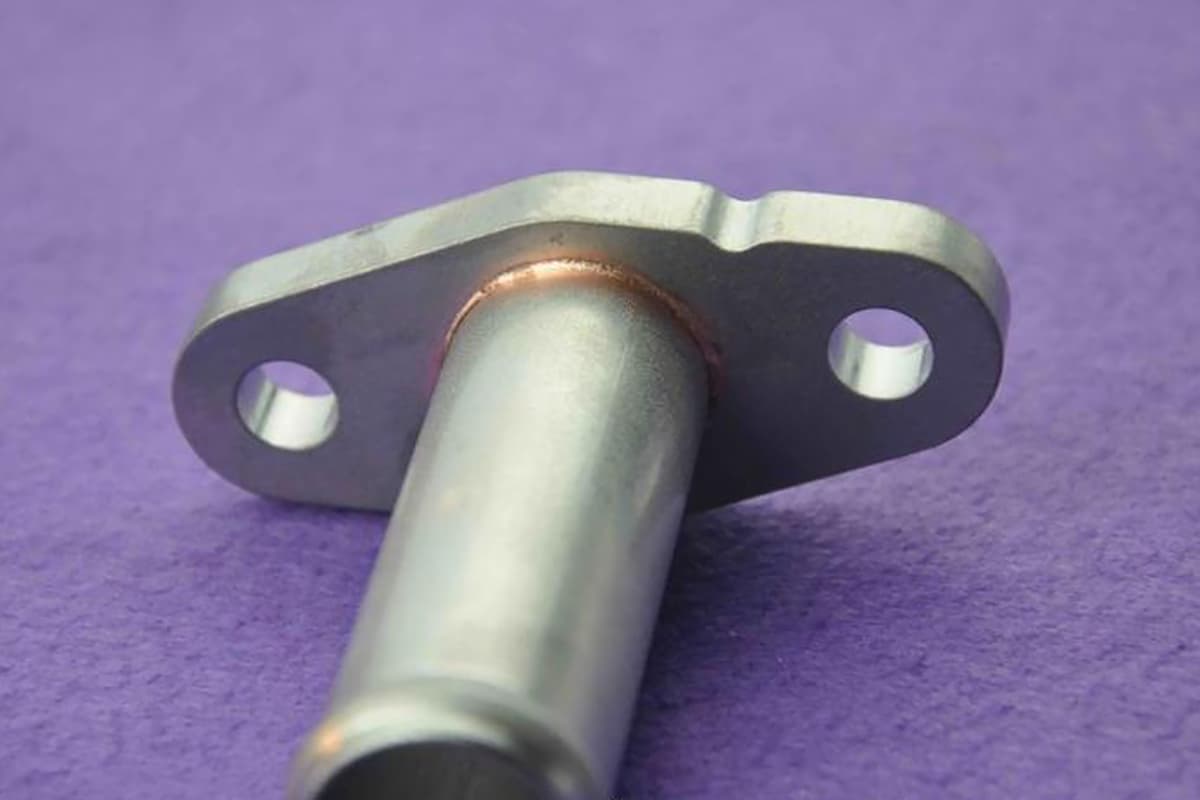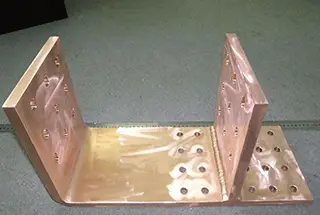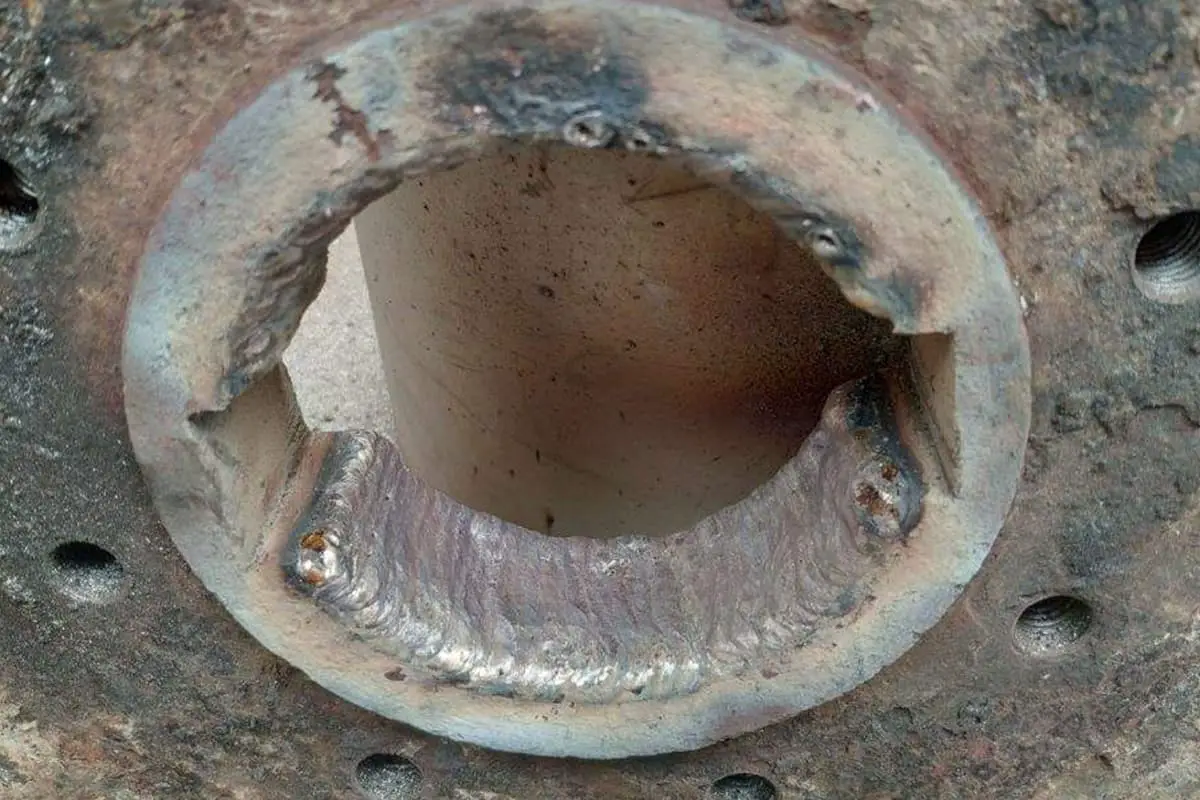
1. Brazing Characteristics Brazing of graphite and diamond polycrystalline materials faces similar challenges as ceramic brazing. Compared to metals, brazing filler metals have difficulty wetting graphite and diamond polycrystalline materials, and their thermal expansion coefficients differ significantly from those of typical structural materials. If heated directly in the air, oxidation or carbide formation can occur […]

Brazing of graphite and diamond polycrystalline materials faces similar challenges as ceramic brazing.
Compared to metals, brazing filler metals have difficulty wetting graphite and diamond polycrystalline materials, and their thermal expansion coefficients differ significantly from those of typical structural materials. If heated directly in the air, oxidation or carbide formation can occur when the temperature exceeds 400°C.

Therefore, vacuum brazing should be adopted, with a vacuum level not lower than 10-1 Pa. Since both graphite and diamond polycrystalline materials have low strength, the presence of thermal stresses during brazing may lead to crack formation.
It is important to select filler metals with low thermal expansion coefficient and strictly control the cooling rate.
Since the surface of such materials is not easily wetted by typical brazing filler metals, pre-brazing surface modification methods such as vacuum coating, ion sputtering, or plasma spraying can be employed to deposit a 2.5-12.5um thick layer of elements like W and Mo on the surface of the graphite and diamond polycrystalline materials, forming corresponding carbides, or high-activity brazing filler metals can be used.
Graphite and diamond come in various grades, differing in particle size, density, purity, and other aspects, and having different brazing characteristics.
Moreover, for diamond polycrystalline materials in a vacuum environment, if the temperature exceeds 1000°C, the wear ratio starts to decrease, and if it exceeds 1200°C, the wear ratio decreases by more than 50%.
Therefore, when vacuum brazing diamonds, the brazing temperature must be controlled below 1200°C, with a vacuum level not lower than 5×10-2 Pa.
The selection of filler metal mainly depends on the application and surface processing conditions. When used as heat-resistant materials, brazing fillers with higher brazing temperature and good heat resistance should be chosen.
For chemical corrosion resistance materials, brazing fillers with lower brazing temperature and good corrosion resistance should be selected. For graphite that has undergone surface metallization treatment, ductile and corrosion-resistant pure copper filler metals can be used.
Silver-based and copper-based active filler metals have good wetting and flowability on both graphite and diamond, but the usage temperature of the brazed joint should not exceed 400°C.
For graphite components and diamond tools used between 400 to 800°C, gold-based, palladium-based, manganese-based, or titanium-based brazing fillers are typically used. For joints used between 800 to 1000°C, nickel-based or tungsten-based brazing fillers are chosen.
When graphite components are used above 1000°C, pure metal filler metals (Ni, Pd, Ti) or alloy filler metals containing elements such as molybdenum (Mo) or tantalum (Ta) that can form carbides with carbon can be used.
For graphite or diamond without surface treatment, active brazing fillers listed in Table 16 can be used for direct brazing. These filler metals are mostly titanium-based binary or ternary alloys. Pure titanium reacts strongly with graphite, forming a thick carbide layer, and its linear expansion coefficient differs significantly from that of graphite, leading to crack formation.
Therefore, it cannot be used as a filler metal. Adding Cr and Ni to Ti can lower the melting point and improve wetting with ceramics. The ternary alloys based on Ti-Zr, with the addition of elements like Ta and Nb, have low linear expansion coefficient, reducing brazing stress.
Ternary alloys mainly based on Ti-Cu are suitable for brazing of graphite and steel, providing high corrosion resistance to the joints.
Table 16: Filler metals for direct brazing of graphite and diamond.
| Solder material | Soldering temperature (°C) | Joint materials and application fields |
| B-Ti50Ni50 | 960~1010 | Graphite-graphite, graphite-titanium, electrolytic cell terminal |
| B-Ti72Ni28 | 1000~1030 | |
| B-Ti93Ni7 | 1560 | Graphite-graphite, graphite-BeO, aerospace sector |
| B-Ti52Cr48 | 1420 | Graphite-graphite, graphite-titanium |
| B-Ag72Cu28Ti | 950 | Graphite-graphite, nuclear reactor |
| B-Cu80Ti10Sn10 | 1150 | Graphite-steel |
| B-Ti55Cu40Si5 | 950~1020 | Graphite-graphite, graphite-titanium, wear-resistant components |
| B-Ti45.5Cu48.5-A16 | 960~1040 | Graphite-graphite, graphite-titanium, wear-resistant components |
| B-Ti54Cr25V21 | 1550~1650 | Graphite-refractory metals |
| B-Ti47.5Zr47.5Ta5 | 1600~2100 | Graphite-graphite |
| B-Ti47.5Zr47.5Nb5 | 1600~1700 | Graphite-graphite, graphite-molybdenum |
| B-Ti43Zr42Gel5 | 1300~1600 | Graphite-graphite |
| B-Ni36-40 Ti5~10 Fe50~59 | 1300~1400 | Graphite-molybdenum, graphite-silicon carbide, heating elements |
Graphite brazing methods can be divided into two categories: one is brazing after surface metallization, and the other is brazing without surface treatment. Regardless of the method used, before assembling the brazed parts, the parts should be pre-treated by wiping the surface of the graphite material with alcohol or acetone to remove any contaminants.
When using surface metallization brazing, a layer of Ni or Cu can be electroplated on the graphite surface, or a layer of Ti, Zr, or molybdenum disilicide can be deposited using plasma spraying.
Then, copper-based or silver-based brazing materials are used for the brazing process. The most commonly employed method is direct brazing using active brazing materials, and the brazing temperature can be selected based on the brazing materials provided in Table 16.
The brazing material can be placed in the middle or near one end of the brazed joint. When brazing with metals that have a high coefficient of thermal expansion, a certain thickness of Mo or Ti can be used as an intermediate buffer layer.
This transition layer can undergo plastic deformation during heating, absorbing thermal stress and preventing graphite from cracking.
For example, for vacuum brazing of graphite and corrosion-resistant nickel-based Hastelloy N components, a B-Pd60Ni35Cr5 brazing material with good resistance to molten salt corrosion and radiation resistance is used. The brazing temperature is 1260℃, and the insulation time is 10 minutes.
Natural diamond can be directly brazed using active brazing materials such as B-Ag68.8Cu16.7Ti4.5 and B-Ag66Cu26Ti8. Brazing should be carried out under vacuum or low argon gas protection. The brazing temperature should not exceed 850℃, and a faster heating rate should be selected.
The holding time at the brazing temperature should not be too long (usually around 10 seconds) to prevent the formation of a continuous TiC layer at the interface.
When brazing diamonds to alloy steel, a plastic intermediate layer or low-expansion alloy layer should be used for transition to prevent excessive thermal stress that can damage the diamond grains.
Brazing processes are used to manufacture ultra-precision machining tools such as turning tools or boring tools by brazing small diamond particles (20-100mg) onto a steel body. The joint strength of the brazed seam reaches 200-250MPa.
Polycrystalline diamond can be brazed using flame brazing, high-frequency brazing, or vacuum brazing. Diamond circular saw blades used for cutting metals or stones should be brazed using high-frequency brazing or flame brazing with low-melting-point active brazing materials such as Ag-Cu-Ti.
The brazing temperature should be controlled below 850℃, and the heating time should not be too long. Slow cooling should be adopted. For polycrystalline diamond drill bits used in petroleum and geological drilling, which are subjected to harsh working conditions and significant impact loads, nickel-based brazing materials can be selected, and pure copper foil can be used as an intermediate layer for vacuum brazing.
For example, to braze 350-400 cylindrical polycrystalline diamond particles (4.5-4.5mm) into the tooth holes of 35CrMo or 40CrNiMo steel to form cutting teeth, vacuum brazing is employed with a vacuum degree not lower than 5×10-2Pa. The brazing temperature is 1020±5℃, the insulation time is 20±2 minutes, and the shear strength of the brazed seam is greater than 200MPa.
During brazing, it is advisable to utilize the weight of the workpiece for assembly and positioning, allowing the metallic parts to press down on the graphite or polycrystalline material. When using fixtures for positioning, the material of the fixtures should have a thermal expansion coefficient similar to that of the workpiece.
Brazing of Aluminum-Based Composite Materials (1) Brazing Characteristics Aluminum-based composite materials are mainly classified into two categories: particle (including whisker) reinforced and fiber reinforced, with materials such as B, CB, SiC used for reinforcement.
During the heating of aluminum-based composite materials for brazing, the base Al easily undergoes chemical reactions with the reinforcing phase. For example, Si in the brazing material diffuses rapidly into the base material, leading to the formation of a brittle droplet layer. This reduces the material’s performance.
Additionally, due to the significant difference in linear expansion coefficient between Al and the reinforcing phase, improper brazing heating can generate thermal stress at the interface, leading to joint cracking.
Furthermore, there is poor wettability between the brazing material and the reinforcing phase, necessitating surface treatment of the composite material for brazing or the use of active brazing materials. Vacuum brazing should be adopted whenever possible.
(2) Brazing Materials and Process
B or SiC particle-reinforced aluminum-based composite materials can be brazed using soft brazing techniques. Prior to brazing, surface treatment can be conducted through sandpaper polishing, wire brushing, alkaline washing, or electroless nickel plating (coating thickness of 0.05mm).
Brazing materials such as S-Cd95Ag, S-Zn95Al, and S-Cd83Zn can be used, with gentle oxy-acetylene flame heating. Moreover, using S-Zn95Al brazing material for friction stir brazing can achieve high joint strength.
Vacuum brazing can be applied for joining short fiber-reinforced 6061 aluminum-based composite materials. The surface should undergo grinding and be polished with 800-grit sandpaper before being cleaned in acetone using ultrasonic cleaning.
Al-Si brazing materials are mainly used, and to prevent Si diffusion into the base material, a barrier layer of pure aluminum foil can be coated on the brazing surface of the composite material.
Alternatively, a B-Al64SiMgBi (11.65i-15Mg-0.5Bi) brazing material with lower brazing strength can be chosen. The melting temperature range of this brazing material is 554-572℃, and the brazing temperature can be selected as 580-590℃ with a brazing time of 5 minutes. The joint shear strength is greater than 80MPa.
For aluminum-based composite materials with graphite particle reinforcement, vacuum brazing in a protective atmosphere furnace is the most successful method. To improve wettability, Al-Si brazing materials containing Mg must be used.
Similar to vacuum brazing of aluminum, the introduction of Mg vapor or Ti degassing, as well as the addition of a certain amount of Mg, can significantly improve the wettability of the brazing material for aluminum-based composite materials.
Solderability of various materials
| Materials | Solderability | Solder material | Flux | Note | ||
| Hard soldering | Soft soldering | |||||
| Carbon steel, low alloy structural steel | Excellent | Excellent | Copper-zinc solder HL-104 Brass Silver-based solder Tin-lead solder | Borax or a mixture of borax and boric acid Borax or protective gas soldering OJ102 OJ104 Zinc chloride or a mixture of zinc chloride and ammonium chloride | ||
| Carbon tool steel | Good | – | HL-104 Brass Silver-based solder | Borax or a mixture of borax and boric acid Borax or soldering with protective gas OJ102 OJ104 | ||
| High-speed steel and carbon steel | Good | – | High carbon manganese steel | Borax | ||
| Hard alloy | Good | – | HL-104 HL-301 | Borax or a mixture of borax and boric acid OJ102 | ||
| Cast iron | Good | – | HL-104 Silver-based solder | Borax or a mixture of borax and boric acid OJ102 | ||
| Stainless steel | 1Cr18Ni9Ti (stainless steel) | Good | Good | Copper-nickel solder Copper Silver-based solder Nickel-based solder Manganese-based solder Tin-lead solder | OJ104 OJ104, gas shielded welding OJ102, OJ104 Grade 201, gas shielded or vacuum brazing Gas shielded or vacuum brazing Phosphoric acid solution, hydrochloric acid solution of zinc chloride | |
| Stainless steel | 1Cr3 (stainless steel) | Good | – | Copper-nickel solder CopperSilver-based solder Nickel-based solder Manganese-based solder Tin-lead solder | OJ104OJ104, gas shielded welding OJ102, OJ104 Grade 201, gas shielded or vacuum brazing Gas shielded or vacuum brazing Phosphoric acid solution, hydrochloric acid solution of zinc chloride | |
| High-temperature alloy | Good | – | Silver-based solder Copper Nickel-based solder | OJ102 Gas shielded or vacuum brazing Gas shielded or vacuum brazing | ||
| Silver | Excellent | Excellent | Silver-based solder Tin-lead solder | OJ102, OJ104 Rosin alcohol solution | ||
| Copper, brass, bronze | Excellent | Excellent | Copper-phosphorus solder Copper-zinc solderSilver-based solder Cadmium-based solder Lead-based solder Tin-lead solder | No flux is needed for copper welding. For copper alloys, borax or a mixture of borax and boric acid can be used as flux. Borax or a mixture of borax and boric acid OJ102 OJ104 OJ205 Zinc chloride solution Rosin alcohol solution, zinc chloride or zinc chloride-ammonium chloride solution | ||
| Aluminum and aluminum alloys | L2, LF21 (aluminium alloys) | Excellent | Excellent | Aluminum-based solder HJ501 zinc-tin solder HJ502 zinc-cadmium solder HJ607 aluminum soft solder HJ607 aluminum soft solder Aluminum solder plate | OJ201, OJ206 Scraper method OJ203 OJ204 OJ202 Flux No.1, No.2 for dip soldering | No flux is needed for vacuum brazing. |
| Aluminum and aluminum alloys | LF1, LF1-2 (aluminium alloys) | Good | Good | |||
| Aluminum and aluminum alloys | LF5, LF6 (aluminium alloys) | Poor | Poor | |||
| Aluminum and aluminum alloys | LD2 (aluminium alloys) | Good | – | Aluminum-based solder | OJ201, OJ206 | Be careful to prevent overheating |
| Aluminum and aluminum alloys | LD5, LD6 (aluminium alloys) | Difficult | – | HL402 aluminum-based solder | Flux No.1 and No.2 for dip soldering | Prone to overheating, it is recommended to use dip soldering |
| Aluminum and aluminum alloys | LY12, LC4 (aluminium alloys) | Poor | – | Very prone to overheating, not suitable for soldering | ||
| Cast aluminum alloys | Al-Cu series (aluminium-copper alloys) | Difficult | – | HL505 | OJ202 | Tends to overheat easily |
| Cast aluminum alloys | Al-Si series (aluminium-silicon alloys) | Difficult | – | HL401, HL505 | OJ201, OJ202 | Poor wetting |
| Cast aluminum alloys | Al-Mg series (aluminium-magnesium alloys) | Poor | – | Difficult to remove surface oxides, difficult to solder | ||
| Cast aluminum alloys | Al-Zn series (aluminium-zinc alloys) | Good | – | Aluminum-based solder | OJ201, OJ206 | |
| Cast aluminum alloys | Die casting parts | Poor | – | Bubbling on the surface of the base material | ||
| Titanium and titanium alloys | Good | – | Ag-5Al-0.5Mn Ti-15Cu-15Ni | Vacuum or gas shielded brazing | Lower joint ductility | |
| Diamond and steel | – | – | HL104 | Borax | Be careful to prevent cracking | |
| Aluminum and copper | – | – | 90Sn-10Zn 99Zn-1Pb | Alternatively, the aluminum surface can be copper-plated before soldering | Alternatively, aluminum surface can be copper-plated before soldering | |
| Titanium and steel, titanium and stainless steel | – | – | HL308 Ag-5Al-0.5Mn | Vacuum or gas shielded brazing | Joint is relatively brittle | |
| Aluminum and iron | – | Excellent | HL502 90Sn-10Zn | OJ205 OJ203 | Alternatively, aluminum surface can be copper-plated before soldering | |
| Ceramic-ceramic, ceramic-metal | – | – | 72Ag-28Cu+Ti powder | Vacuum or gas shielded brazing | Or, after metallizing the ceramic surface, soldering can be performed | |
| Graphite | – | – | 72Ag-28Cu+Ti powder, Ti-Cu, Ti-Ni | Vacuum or gas shielded brazing | ||







